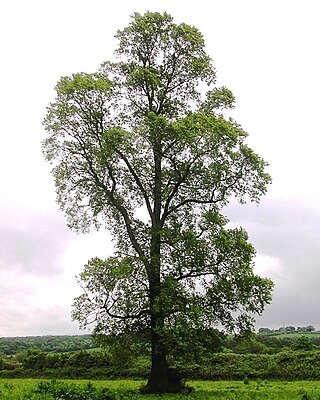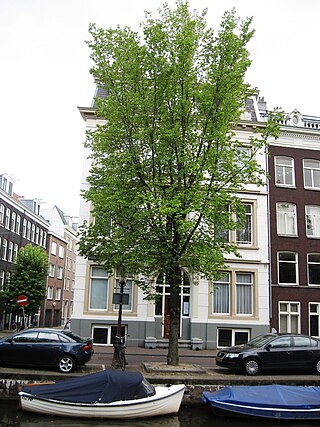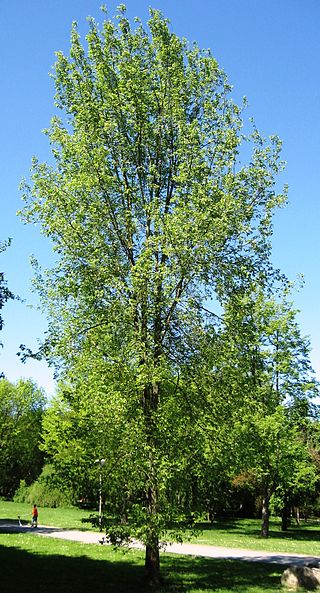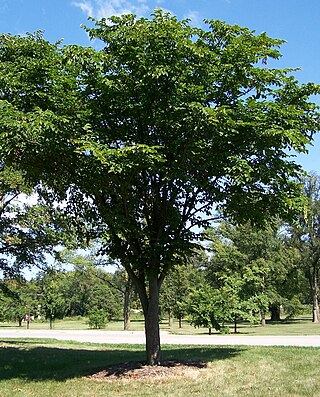
Elms are deciduous and semi-deciduous trees comprising the genus Ulmus in the family Ulmaceae. They are distributed over most of the Northern Hemisphere, inhabiting the temperate and tropical-montane regions of North America and Eurasia, presently ranging southward in the Middle East to Lebanon and Israel, and across the Equator in the Far East into Indonesia.

Ulmus wallichianaPlanch., the Himalayan elm, also known as the Kashmir elm and Bhutan elm, is a mountain tree ranging from central Nuristan in Afghanistan, through northern Pakistan and northern India to western Nepal at elevations of 800–3000 m. Although dissimilar in appearance, its common name is occasionally used in error for the cherry bark elm Ulmus villosa, which is also endemic to the Kashmir, but inhabits the valleys, not the mountain slopes. The species is closely related to the wych elm U. glabra.

Ulmus davidiana var. japonica, the Japanese elm, is one of the larger and more graceful Asiatic elms, endemic to much of continental northeast Asia and Japan, where it grows in swamp forest on young alluvial soils, although much of this habitat has now been lost to intensive rice cultivation.

Ulmus laciniata(Trautv.) Mayr, known variously as the Manchurian, cut-leaf, or lobed elm, is a deciduous tree native to the humid ravine forests of Japan, Korea, northern China, eastern Siberia and Sakhalin, growing alongside Cercidiphyllum japonicum, Aesculus turbinata, and Pterocarya rhoifolia, at elevations of 700–2200 m, though sometimes lower in more northern latitudes, notably in Hokkaido.

Ulmus 'Clusius' is a Dutch hybrid elm cultivar raised at the Dorschkamp Research Institute for Forestry & Landscape Planning, Wageningen, and released to commerce in 1983. 'Clusius' was derived from a crossing of the same Dutch clones that produced the fastigiate 'Lobel' released in 1973: '202' and '336'.

The Dutch hybrid cultivar Ulmus 'Dodoens' was derived from a selfed seedling of a crossing of the Exeter Elm Ulmus 'Exoniensis' with the Himalayan Elm Ulmus wallichiana at the Dorschkamp Research Institute for Forestry & Landscape Planning, Wageningen. The tree was one of several cultivars prepared for release in 1970, but delayed by the outbreak of the second, far more aggressive strain of Dutch elm disease.

The Dutch hybrid elm cultivar Ulmus × hollandica 'Groeneveld' was cloned in 1949 at the De Dorschkamp Institute, Wageningen, and released in 1963 in response to the earlier, less virulent form of Dutch elm disease that afflicted Europe shortly after the First World War. The cultivar was derived from a crossing of Dutch clones '49', and '1', a Field Elm Ulmus minor found in central France and marketed by the Barbier nursery in Orléans.

Ulmus 'Homestead' is an American hybrid elm cultivar raised by Alden Townsend of the United States National Arboretum at the Nursery Crops Laboratory in Delaware, Ohio. The cultivar arose from a 1970 crossing of the Siberian Elm Ulmus pumila with the hybrid N 215, the latter grown from seed sent in 1960 to the University of Wisconsin-Madison elm breeding team by Hans Heybroek of the De Dorschkamp Research Institute in the Netherlands. Tested in the US National Elm Trial coordinated by Colorado State University, 'Homestead' averaged a survival rate of 85% after 10 years in the US National Elm Trial. However, planting of the tree was not recommended, owing principally to its 'ugly' shape and susceptibility to Southwest injury. 'Homestead' was released to commerce without patent restrictions in 1984.

Ulmus 'Lobel' is a Dutch hybrid cultivar raised at the Dorschkamp Research Institute for Forestry & Landscape Planning, Wageningen, from a crossing of clone '202' with '336'. 'Lobel' was cloned in 1962 and released for sale in 1973.

Ulmus 'Plantyn' was one of three Dutch hybrid elms released by the Dorschkamp Research Institute for Forestry & Landscape Planning, Wageningen, in 1973. Derived from a crossing of the Dutch hybrids '202' and '302', it was to prove of great significance in later developments. A selfed seedling was to become the first Dutch clone to prove effectively immune to disease, released in 1989 as 'Columella'. 'Plantyn' was also destined to be the female parent of Lutèce released in 2002. In Italy, 'Plantyn' was used again as female parent in hybridizations with the Siberian Elm Ulmus pumila by the Istituto per la Protezione delle Piante (IPP), to create three new cultivars better adapted to the Mediterranean climate.

Ulmus 'Regal' is an American hybrid elm cultivar developed by the University of Wisconsin–Madison and released in 1983. 'Regal' was derived from seeds arising from the crossing of the Dutch hybrid clones 'Commelin' and '215' sent in 1960 by Hans M. Heybroek of the Dorschkamp Research Institute for Forestry & Landscape Planning, Wageningen, Netherlands.

Ulmus 'Columella' is a Dutch elm cultivar raised by the Dorschkamp Research Institute for Forestry & Landscape Planning, Wageningen. Originally thought to have been derived from a selfed or openly pollinated seedling of the hybrid clone 'Plantyn', DNA analysis later determined it arose from a cross of 'Plantyn' and Ulmus minor. Sown in 1967, it was released for sale in 1989 after proving extremely resistant to Dutch elm disease following injection with unnaturally high doses of the pathogen, Ophiostoma novo-ulmi. However, propagated by grafting onto wych elm rootstocks, graft failure owing to incompatibility has become a common occurrence in the Netherlands.
Ulmus 'Stavast' is a Dutch hybrid elm cultivar raised at the Dorschkamp Research Institute for Forestry & Landscape Planning, Wageningen, as clone '622' from the crossing of 'Commelin' with clone '202', itself a hybrid of the Exeter Elm Ulmus 'Exoniensis' and Himalayan Elm Ulmus wallichiana.

The Field Elm cultivar Ulmus minor 'Christine Buisman' was the first cultivar released by the Dutch elm breeding programme, initiated in response to the less virulent form of Dutch elm disease (DED), Ophiostoma ulmi, which afflicted Europe's elms after the First World War. 'Christine Buisman' was selected from a batch of 390 seedlings grown from seed collected in the Parque de la Quinta de la Fuente del Berro, Madrid, by Mrs Van Eeghen, a friend of elm researcher Johanna Westerdijk, in 1929 and named for the elm disease researcher Christine Buisman. Originally identified as Ulmus foliacea, it was later treated as Ulmus × hollandica by Melville. However, more recent research in Belgium using DNA markers has reaffirmed 'Christine Buisman' as a clone of U. minor.

The elm cultivar Ulmus minor 'Bea Schwarz' was cloned at Wageningen in the Netherlands, by the elm disease committee, from a selection of Ulmus minor found in France in 1939. However, specimens of the tree grown in the UK and the United States are falsely treated as Ulmus × hollandica.

The Japanese Elm cultivar Ulmus davidianavar.japonica 'Jacan' is a cold-resistant selection from Canada. The tree was one of a group of second-generation japonica seedlings raised in the 1970s, originally for use in the prairie regions, by the Morden Research Station, Morden, Manitoba. It was first distributed in 1977, and was later among the Asiatic elms, some sourced from Canada, donated to the UK in 1980 by the London branch of Mitsui & Co.
Ulmus davidianavar.japonica 'Thomson' is a hardy, cold-resistant cultivar of the Japanese Elm assessed by the Prairie Farm Rehabilitation Administration (PFRA) Nursery at Indian Head, Saskatchewan, in the 1970s as part of its shelterbelt tree research..
Ulmus davidianavar.japonica 'JFS-Bieberich' is a Japanese Elm cultivar that was raised by the Sunshine Nursery, Oklahoma, from seed collected in China by proprietor Steve Bieberich. Emerald Sunshine proved only moderately successful in the US National Elm Trial, averaging a survival rate of 70% overall.

Ulmus laciniata var. nikkoensisRehder, the Nikko elm, was discovered as a seedling near Lake Chūzenji, near Nikkō, Japan, and obtained by the Arnold Arboretum in 1905. The taxonomy of the tree remains a matter of contention, and has been considered possibly a hybrid of U. laciniata and U. davidiana var. japonica. However, in crossability experiments at the Arnold Arboretum in the 1970s, U. laciniata, a protogynous species, was found to be incompatible with U. davidiana var. japonica, which is protandrous.

Simon Godfried Albert Doorenbos was a Dutch horticulturist best known for his work as Director of The Hague Parks Department from 1927 until his retirement in 1957, with a brief interruption during the Second World War when he was dismissed and evicted by the Nazis for refusing to remove trees and shrubs to facilitate the construction of a V1 flying bomb launch pad.

















